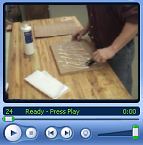 |
|
|
|
|
|
Part 1 |
No matter how many times you've used a vacuum press, there's always a moment of slight anxiety when you pull a veneered panel out of the press. You're wondering if there will be bubbles, ripples, delamination, or seam separation. Here are a few tips to ease the worry and avoid the most common mistakes when working with veneer. 1: Store the Veneer Carefully Burl and crotch veneers can be stored in anything that will minimize changes in moisture content. Plastic "cling" wrap or even a trash bag can be used for this purpose. Long wood veneers are typically rolled up for shipment. Exercise care when opening a roll of wood veneer. Don't let the veneer get out of hand and spring open. Ideally, these veneers should be stored flat between two pieces of plywood or MDF and then placed on a shelf. This method of storage minimizes rapid changes in moisture content and prevents color fading caused by exposure to UV rays from sun and fluorescent light. For both burl and long wood veneers, it is helpful store the veneer flat and preferably with evenly distributed weight on top. 2: Prepare the Surfaces Properly For all substrates For paper-backed veneer For raw wood veneer 3: Choose the Right Glue Contact cement is only suitable for paper backed and 2 ply veneer. It's a common beginner mistake to use contact cement or yellow wood glue on raw wood veneers. Neither of these adhesives dry hard and yellow glue has a tendency to bleed-through. We recommend Better Bond X-Press™ veneer glue since it dries fast, cures hard and requires no mixing. It is made specifically for raw wood veneer and it's very easy to apply.
Bonus Tip: Veneer can have a tendency to curl up when it is placed on the wet glue layer on the substrate. Do not spray the face side of the veneer with water to counteract the curling. The addition of water to the veneer causes excessive expansion of the wood cells which can cause the veneer to split later in the day as the moisture evaporates from the saturated wood cells. 5: Minimize Warping with a Balance Veneer One of the most common veneering problems is the tendency of the panel to warp after it is removed from the press. You can eliminate this issue by veneering both sides of the panel. A balance veneer is a veneer that is applied to the back side of the substrate. This will even out the stress placed on the substrate as the glue dries and the veneer settles into its final position on the panel. Learn more about balance veneer use on this page. Large Panels Small & Medium Panels 6: Vacuum Press the Panel for Best Results A vacuum press is the ideal tool for clamping veneer to a substrate because it applies a significant amount of even pressure distributed across the entire surface. If you do not have a vacuum press, you can usually get a good finished panel with clamps and weights. The key is to make sure the pressure is evenly distributed. Otherwise, the glue may create ridges and bubbles in the veneer. This will ruin the panel. Click here for more information about veneering without a vacuum. 7: Allow the Panel to Dry Correctly Better Bond X-Press™ veneer glue requires 60 minutes inside the vacuum bag to "set", but the actual curing takes another 3 to 4 hours outside of the bag. Be sure to let the panel dry completely before you do any sanding or machining. Don't leave the veneered panel in the press longer than the glue specifies because some veneer adhesives can get "globby" which then causes ripples and bubbles to form in the veneer. Additionally, panels left in the press for too long can develop patches of mold. I've seen cherry and maple develop mold with less than 4 hours of clamping time. Ultra-CAT™ veneer glue requires 4 to 6 hours of time inside the bag. It cures through a chemical reaction instead of evaporation. Panel warping can be prevented by allowing both sides of the panel to dry evenly. Small light-weight panels can simply be hung by spring clamps suspended from rope or string. Large panels can be placed on a flat surface with dowels or PVC pipe underneath to allow air flow and allow even drying of both sides of the panel. For more information, be sure to check out the "Curing Glued Panels" page. 8: Trim the Panel Using the Right Tool Instead of cutting the substrate to the exact size, I often prefer to cut my substrate panels one-half inch larger on each side and then apply a veneer that is a half inch smaller (on all sides) than the substrate. I typically line up one edge of the veneer with one edge of the substrate so that the veneer is inside the edge of the substrate by an eighth of an inch. Then I use blue painter's tape to hold it in place. Once the panel has cured, I use my table saw, with a plywood cross cutting blade, to do the final cutting of the panel. I start by cutting the side opposite from where I lined up the edge of the veneer slightly off the edge of the substrate. Then I go back to the other side and trim the panel to its final side. 9: Avoid Sanding Through the Veneer It is every veneer user's nightmare to have a perfect panel ruined because the sander cut through the veneer. It's no less than instant disappointment when the glue surface becomes visible. Don't let a worry about sanding through a panel prevent you from veneering a project. I've been there and I've learned from it. Do yourself a favor and make a couple of test panels using a softwood veneer like walnut or redwood and a hardwood veneer like maple or Karelian birch burl. These panels don't have to be large. Even an 8" x 10" sample works fine. Apply the glue to the substrate, press the panel, and let it cure. Draw a dozen or more lines across the veneer surface with a pencil. Be sure the pencil lines go all the way out to to the edges of the panel since this is where many sand-through mistakes can happen. Then use your favorite tool to sand the panel. I use a random orbit sander typically starting with 120 grit. Watch the sanding lines disappear and note where they are removed easiest. You will likely find that the edges of the panel are where the pencil lines are removed with the least amount of effort.
Continue sanding the panel and trying various amounts of pressure on the tool to see how it affects the removal of the pencil markings. You would normally stop sanding when the pencil lines are removed and the panel is smooth, but in this case go ahead and keep sanding. The goal here is to sand down to the glue layer so that you get a feel for exactly how long you can sand before disaster strikes.
Consider making a few of these test panels and test mistakes and with that you will have gained invaluable knowledge that will help you avoid sanding through a project veneer panel. I draw pencil lines on every veneered project in my shop as a reference for the softness of the veneer. If the line is difficult to remove, then I know I have a hard veneer which I will not easily sand through. I also use the pencil trick to help avoid sanding through if the veneer requires any grain filling or if the raw veneer required a patch piece. Sometimes I end up with some light pencil markings left on the veneer but these are easily removed with a little denatured alcohol on a paper towel. Be sure to check out the Veneering FAQ for more information. |
|
|
|







